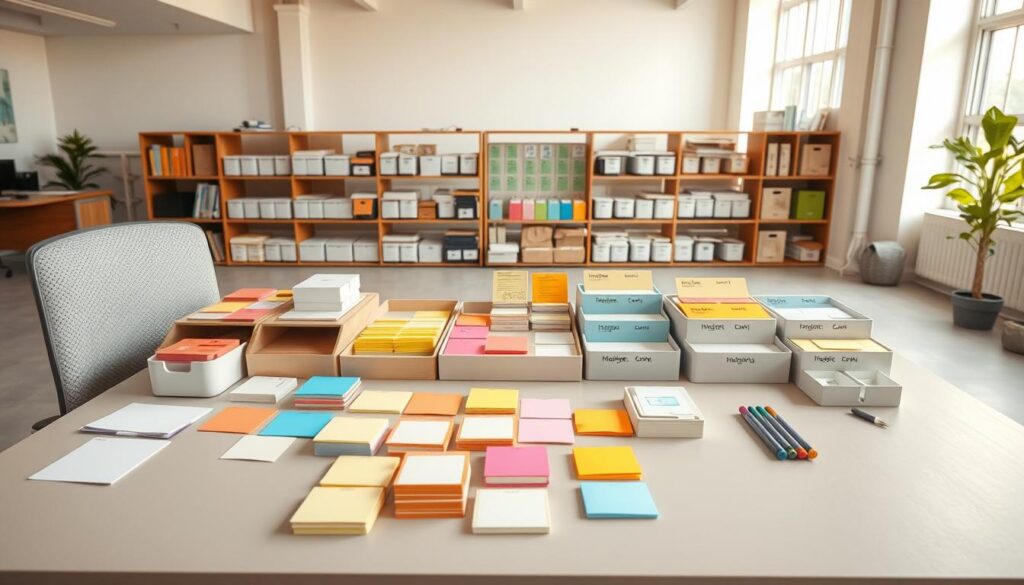Have you ever wondered why some websites just make sense while others leave you lost and frustrated?
Behind the smoothest user experiences lies a simple yet powerful method that reveals how real people think about content. It’s not flashy, but it’s incredibly effective — and it could be the missing piece in your UX strategy.
Stick around because what happens next might change how you organize your site forever.
What Is Card Sorting in UX?
The card-sorting technique is a key method in UX research. It lets users group topics into meaningful categories. This helps in creating site structures that match user logic and preferences.
Since its start in the late 1990s, it has grown to meet various user needs and tech advancements.
Card sorting shows how users organize information, making information architecture better. It helps designers create easier navigation paths. This reduces bounce rates and makes the website structure more user-friendly.
Card sorting comes in three main types: open, closed, and hybrid.
You need 15 participants in a qualitative study to effectively understand user mental models. For a quantitative study, 30-50 participants are required for reliable groupings. Also, keeping the number of cards to 30-50 helps avoid user fatigue and ensures thoughtful sorting, as seen in a recent project.
Remote card sorting is now more popular because it’s efficient. It allows researchers to reach a wide range of users.

Importance of Card Sorting in User Experience
Card sorting in UX projects makes content easier to use and navigate. It helps designers understand how users think about information. This is key for creating a site where users can easily find what they need.
Card sorting is a way to see how users move through a digital product. A study by the Nielsen Norman Group suggests using at least 15 people for this. This ensures a wide range of opinions on the site’s layout.
You can use this method quickly and repeat it as often as needed. It’s great for getting the information you need fast.
To really make card sorting work, pair it with usability testing. This combo checks if the site’s navigation is easy to use. It makes sure the site is not only well-organized but also meets user needs.
Types of Card Sorting Methods
There are three main types of card-sorting. Each one offers unique insights depending on where you are in the design process.
- Open Card Sorting: Allows participants to group content however they see fit and create their own category names. This method is especially useful in the early stages of a project. It helps when you’re still exploring how users naturally think about and categorize. It helps uncover mental models and unexpected patterns.
- Closed Card Sorting: Asks users to sort items into categories you’ve already defined. This is ideal for validating an existing site structure or testing whether your labels and groupings make sense to users.
- Hybrid Card Sorting: Combines the two approaches. Users can sort cards into your predefined categories, but also have the freedom to create new ones if something doesn’t fit. This method is perfect for refining content organization when you want both structure and flexibility.
Pro Tip: Use open sorting for discovery and closed sorting to test your navigation logic.

When To Use Card Sorting in Your Project
Timing is everything when it comes to card-sorting. Knowing when to use it can make all the difference in shaping a user-friendly experience.
Start your project with card-sorting to uncover how users naturally group information. This early input helps shape a structure that feels intuitive from the very beginning.
Midway through the design process, card sorting can validate whether your current groupings align with user thinking. It’s a great way to catch issues before you bake them into your design.
During a website or product redesign, card sorting helps identify outdated structures. It also helps update them to better reflect how users browse or interact with content.
You can also pair card-sorting with usability testing or tree testing. This combination provides deeper, more actionable insights about navigation and content findability.
It’s a flexible, low-effort research method that fits easily into most UX workflows and delivers high-impact results.
How To Prepare for a Card Sorting Session
A successful card-sorting session doesn’t just happen — it starts with thoughtful preparation. Taking the time to plan properly ensures you get clean, useful insights from your participants.
- Define Your Goal: Be clear on what you’re trying to learn. Are you exploring how users naturally organize content (open sort) or validating an existing structure (closed sort)?
- Select the Right Participants: Aim for at least 15 participants for qualitative feedback. If you want statistically reliable data, shoot for 30 to 50 users.
- Keep the Card Count Manageable: Limit your deck to 30–50 cards. Too many will overwhelm users and lead to drop-off or poor-quality responses.
- Choose the Right Tool: Platforms like OptimalSort, UXtweak, or Maze make remote sessions smooth and trackable.
- Write Clear, Simple Instructions: Clarity is everything. Confused participants won’t deliver helpful data.
- Offer a Small Incentive: Especially for remote sessions, a reward can boost participation and completion rates.

Analyzing Card Sorting Results
Reviewing card-sorting results takes effort, but it’s incredibly useful. We aim to sort data into clear groups and spot patterns. These patterns help shape the information architecture. Tools like dendrograms and matrix spreadsheets are key in showing these patterns.
When many people group things the same way, it shows they share a common view. This means most users can easily understand how the design organizes the information. But if users rely too heavily on certain categories, it might mean those categories are too broad. This could mean we need to break them down into smaller groups.
In open card sorting, people make their own categories. This shows how they naturally think about organizing information. Closed card sorting uses set categories to check if they’re useful. Hybrid card sorting mixes both, giving a full view of user and set categories.
Methods like clustering and similarity matrices find common pairings in the data. The Standardization Grid shows how often users put cards in certain categories. Agreement matrices show which groupings are most popular, with darker cells indicating high agreement.
In qualitative analysis, we dive into why users group things. For example, ‘User Testimonials’ and ‘Client Success Stories’ often go under ‘What we do’. But ‘Blog’ and ‘Industry News’ might go under ‘Industry Insights’, showing different views.
While analyzing card-sorting results takes time and effort, it’s vital for creating a good information architecture. Usability testing adds to these insights, making sure the site is easy to use.
Best Practices for Effective Card Sorting
To get the most value from your card-sorting sessions, it’s important to follow a few key best practices. These tips will help you collect clearer, more actionable data—and ensure a smoother experience for your participants.
- Limit the number of cards to around 40 or fewer. Too many cards can overwhelm users, leading to fatigue and lower-quality results.
- Keep sessions short, ideally under 15 minutes. Respecting your participants’ time keeps them engaged and focused throughout the activity.
- Randomize the card order for each participant. This avoids bias from fixed patterns and gives you a more accurate sense of user expectations.
- Run a pilot test with a few participants first. This helps catch unclear instructions or confusing terminology before the full study.
- Use visuals or icons on cards if they make the content easier to understand, especially for more complex topics.
- Pair card sorting with another UX method, like tree testing or A/B testing, to validate and refine your findings even further.
Real-World Examples of Card Sorting in UX
Card-sorting methods have shown their value in many real-world cases. They help organize content and improve user experience. For example, the Museum of Art & Design in NYC used card-sorting to manage its large collection. They involved three participants with 46 cards each in two sorts.
The SHÍ project is another great example. It started with 13 categories and simplified them to four main ones. This shows how card-sorting can make websites easier to navigate.
A Fortune 500 financial company also used card-sorting. They began with 100 content pieces and narrowed it down to 75 cards. They did five remote sorts and one unmoderated sort with 50 participants. This effort improved content findability by 75%.
The UXtweak card-sorting study is also noteworthy. It involved young parents to find the best way to organize 30 articles. They used a large user panel to find the right participants at a low cost. This made their card-sorting more effective.
These examples show how card-sorting is useful in many areas. It helps improve user experiences and makes navigation easier. Whether it’s for an art museum, a corporate website, or educational content, card sorting is a valuable tool.
Future Trends in Card Sorting for UX
The future of card sorting in UX design looks bright, thanks to new tech like artificial intelligence (AI). AI in UX makes analyzing data faster and more accurate. This means better categorization and navigation for users.
As companies move to agile UX design, card sorting is changing, too. It now fits into quick, ongoing design cycles. This lets designers use user feedback fast, making designs better and faster.
Remote and hybrid card-sorting methods are becoming more popular. They use digital tools to reach more users, saving money. Tools like OptimalSort, UXtweak, and UserZoom also help understand data quickly.
The mix of AI in UX and agile UX design will change card sorting for the better. It will be more efficient and useful for designing better digital experiences. UX pros will be able to create more user-friendly apps and websites.
Map the Mind, Master the Menu: The Power of Card Sorting
Card sorting may seem simple, but its value in UX design is powerful. Users show how they naturally group and find information to achieve this. You’re not just organizing content, you’re creating intuitive pathways that respect how people think.
From simplifying site navigation to validating your content structure, card sorting is a foundational method that blends strategy with empathy. As digital experiences evolve, the best designs will always reflect how real users interact with information.
Want to keep sharpening your UX instincts and building smarter digital experiences? Mood Joy offers insights, tips, and real-world strategies on everything from user research to interface design. Dive into more UX/UI best practices and discover how to create connective designs. Explore the blog now!



